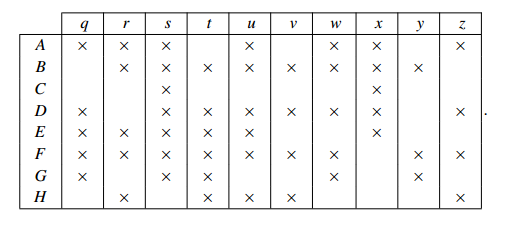

تاريخ الرياضيات

الاعداد و نظريتها

تاريخ التحليل

تار يخ الجبر

الهندسة و التبلوجي


الرياضيات في الحضارات المختلفة

العربية

اليونانية

البابلية

الصينية

المايا

المصرية

الهندية


الرياضيات المتقطعة

المنطق

اسس الرياضيات

فلسفة الرياضيات

مواضيع عامة في المنطق


الجبر

الجبر الخطي

الجبر المجرد

الجبر البولياني

مواضيع عامة في الجبر

الضبابية

نظرية المجموعات

نظرية الزمر

نظرية الحلقات والحقول

نظرية الاعداد

نظرية الفئات

حساب المتجهات

المتتاليات-المتسلسلات

المصفوفات و نظريتها

المثلثات


الهندسة

الهندسة المستوية

الهندسة غير المستوية

مواضيع عامة في الهندسة

التفاضل و التكامل


المعادلات التفاضلية و التكاملية

معادلات تفاضلية

معادلات تكاملية

مواضيع عامة في المعادلات


التحليل

التحليل العددي

التحليل العقدي

التحليل الدالي

مواضيع عامة في التحليل

التحليل الحقيقي

التبلوجيا

نظرية الالعاب

الاحتمالات و الاحصاء

نظرية التحكم

بحوث العمليات

نظرية الكم

الشفرات

الرياضيات التطبيقية

نظريات ومبرهنات


علماء الرياضيات

500AD

500-1499

1000to1499

1500to1599

1600to1649

1650to1699

1700to1749

1750to1779

1780to1799

1800to1819

1820to1829

1830to1839

1840to1849

1850to1859

1860to1864

1865to1869

1870to1874

1875to1879

1880to1884

1885to1889

1890to1894

1895to1899

1900to1904

1905to1909

1910to1914

1915to1919

1920to1924

1925to1929

1930to1939

1940to the present

علماء الرياضيات

الرياضيات في العلوم الاخرى

بحوث و اطاريح جامعية

هل تعلم

طرائق التدريس

الرياضيات العامة

نظرية البيان
Approval Voting
المؤلف:
W.D. Wallis
المصدر:
Mathematics in the Real World
الجزء والصفحة:
190-191
14-2-2016
1551
Approval voting was first used in cases where the number of people to be elected was not fixed. For example, if a committee wants to co-opt a few more members to help organize a function, they might add all those who they think would make a positive contribution, not a fixed number. In that case a member might vote for every suitable candidate, casting as many votes as she wishes; all the votes are considered equal. The number of votes received by a candidate is called his approval rating.
Candidates with an approval rating of at least 50% (or 60%, or some other agreed figure) are elected.
Sometimes there is a strict requirement that a certain number be elected, or a minimum or maximum is imposed. Ties are more common in approval voting than they are in some other systems, and some sort of runoff procedure is often necessary.
The following example illustrates these ideas.
Sample Problem 1.1 Ten board members vote on eight candidates by approval. The candidates are A,B,C,D,E,F,G,H, and the board members are q,r,s,t,u, v,w,x,y,z. They vote as follows (× represents approval).

(i) Which candidate is chosen if just one is to be elected?
(ii) Which candidates are chosen if the top four are to be elected?
(iii) Which candidates are chosen if the top two are to be elected?
(iv) Which candidate or candidates are chosen if at most four are to be elected and 80% approval is required?
Solution. Here is a summary of the votes received:
A−7 B−8 C−2 D−8 E −6 F −9 G−5 H −5.
(i) F, who received the most votes.
(ii) A,B,D,F.
(iii) F is elected; there will need to be a runoff election between B and D.
(iv) B, D and F are elected.
The array in the example is called an approval table; we shall always denote approval with a cross in such tables.
Approval voting is particularly useful for situations like the selection of new employees. In those circumstances there is usually a minimum requirement, and further applications may be called if not enough good applicants are available.